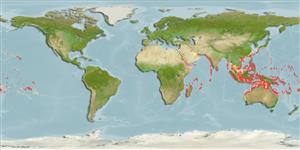分類 / Names
俗名 | 同種異名 | Catalog of Fishes(屬, 種) | ITIS | CoL | WoRMS | Cloffa
Teleostei >
Tetraodontiformes (Puffers and filefishes)
魨形目 (Puffers and filefishes) >
Balistidae (Triggerfishes)
鱗魨科 (Triggerfishes)
Etymology: Pseudobalistes: Greek, pseudes = false + Greek, ballo = to throw (Ref. 45335).
More on author: Rüppell.
Environment: milieu / climate zone / depth range / distribution range
生態學
海洋; 半鹹淡水 礁區魚類; 深度上下限 2 - 80 m (Ref. 1602). 熱帶; 22°C - 27°C (Ref. 130614); 34°N - 34°S, 27°E - 124°W
Indo-Pacific: Red Sea to East Africa eastward through northern Australia reaching Tuamotu Islands, north to southern Japan.
印度-太平洋: 紅海南至南非的納塔爾 (參考文獻 4420) 而且向東經過印尼到 Tuamoto 島, 北至日本南部。
大小 / 重量 / 年齡
Maturity: Lm ? range ? - ? cm
Max length : 60.0 cm TL 雄魚/尚未辨別雌雄; (Ref. 9770)
背棘 (總數) : 3; 背的軟條 (總數) : 24 - 27; 臀棘: 0; 臀鰭軟條: 22 - 25. Scales relatively large (Ref. 9002).
鱗片相當大的.(參考文獻 9002)
Inhabits coastal to inner reefs and estuaries, often in silty habitats (Ref. 48637). Found on lagoon slope and floor (Ref. 30573), also coral reefs. Generally solitary or in pairs (Ref. 4420). Young form small aggregations when common while adults are usually seen solitary, except when nesting and males congregate on certain sand flats adjacent to reefs (Ref. 48637). Feeds on tips of coral branches, gastropods, crustaceans, foraminiferans, and tunicates (Ref. 1602) and also on sea urchins (Ref. 9770). Oviparous (Ref. 205). Nest-guarding females are aggressive (Ref. 9770). Also caught with drive-in nets. Marketed fresh and dried-salted (Ref. 9770). Ciguatoxic in certain areas (Ref. 37816). Maximum depth reported taken from Ref. 128797.
棲息於潟湖斜坡與底部 (參考文獻 30573)了, 也珊瑚礁。 通常獨居性的或成對.(參考文獻 4420) 吃珊瑚分支的尖端,腹足動物,甲殼動物,有孔蟲與被囊類 (參考文獻 1602) 以及吃海膽。 (參考文獻 9770) 卵生的.(參考文獻 205) 守衛巢穴的雌性是侵略性。 (參考文獻 9770) 也用圍網捕獲。 在市場上銷售生鮮或乾漬了。 (參考文獻 9770) 在特定的區域中的有西加毒的.(參考文獻 37816)
Life cycle and mating behavior
成熟度 | 繁殖 | 產卵場 | 卵 | 孕卵數 | 仔魚
Males migrate to a traditional spawning ground where they establish territories enclosing nest sites and egg chambers (Ref. 9777). Nesting occurs in sand-bottomed channels and shallow cuts through the barrier reef (Ref. 9778, 37816). The nest consist of depressions up to 2 m wide and 0.7 m deep (Ref. 9778, 37816). Females arrive several days later and select a male for mating (Ref. 9777). Exhibit biparental care (Ref. 9777). Up to 430,000 or more eggs may be deposited in a spongy fist-sized cluster weighted down with pieces of rubble (Ref. 9778, 37816). Males establish a territory for spawning and parental care but not for feeding (Ref. 116451). Only females tend the eggs but both parents keep guard (Ref. 116451).印度-太平洋: 紅海南至南非的納塔爾 (參考文獻 4420) 而且向東經過印尼到 Tuamoto 島, 北至日本南部。
Myers, R.F., 1991. Micronesian reef fishes. Second Ed. Coral Graphics, Barrigada, Guam. 298 p. (Ref. 1602)
IUCN 瀕危狀態 (Ref. 130435: Version 2024-2)
無危 (LC) ; Date assessed: 13 January 2022
人類使用
漁業: 商業性; 水族館: 商業性
工具
特別的報告
下載 XML
網路資源
Estimates based on models
Preferred temperature (Ref.
123201): 24.7 - 29, mean 27.8 °C (based on 976 cells).
Phylogenetic diversity index (Ref.
82804): PD
50 = 0.6250 [Uniqueness, from 0.5 = low to 2.0 = high].
Bayesian length-weight: a=0.02692 (0.01267 - 0.05719), b=2.92 (2.74 - 3.10), in cm total length, based on LWR estimates for this (Sub)family-body shape (Ref.
93245).
營養階層 (Ref.
69278): 2.8 ±0.26 se; based on food items.
Generation time: 2.2 ( na - na) years. Estimated as median ln(3)/K based on 1
growth studies.
回復力 (Ref.
120179): 高度, 族群倍增時間少於 15個月 (K=0.49; Fec=430,000).
Fishing Vulnerability (Ref.
59153): Low to moderate vulnerability (29 of 100).
Nutrients (Ref.
124155): Calcium = 35.3 [15.1, 84.0] mg/100g; Iron = 0.604 [0.319, 1.321] mg/100g; Protein = 18.7 [16.6, 20.9] %; Omega3 = 0.11 [0.05, 0.22] g/100g; Selenium = 42.7 [20.7, 96.5] μg/100g; VitaminA = 26.4 [6.7, 99.7] μg/100g; Zinc = 1.13 [0.75, 1.74] mg/100g (wet weight);
